Refining old bonsai isn’t always a quick process – especially when the bonsai is a corkbark black pine. With brittle branches, the variety does not lend itself to dramatic restyling. I’ve been fortunate that the pine below has been healthy enough to decandle three years in a row. Many corkbark pines need a year to recover after decandling which further slows progress.
I talked briefly with Akio Kondo about the tree in a workshop this past winter. He encouraged me to continue refining it and removed a few unnecessary shoots. Then, with a big smile, he said, “Wire it.” Only now getting around to the task, I finished wiring just as the new needles began to emerge from the elongating candles.
The tree is still in an awkward stage. At best, I can hope to remove some of the “lumps” in the silhouette while I wait for new shoots to develop. It’s slow work, but I’m happy with the progress to date.

Front – before
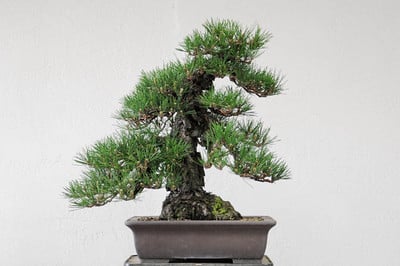
Front – after
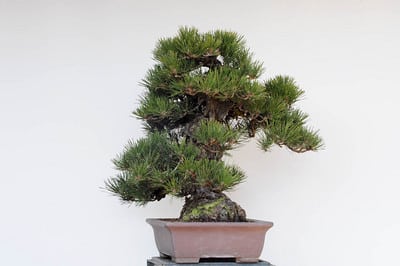
Right – before
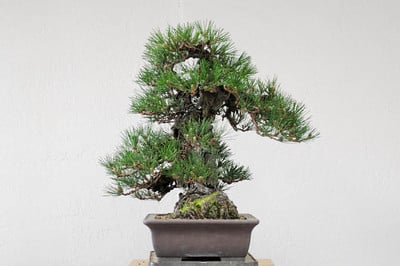
Right – after
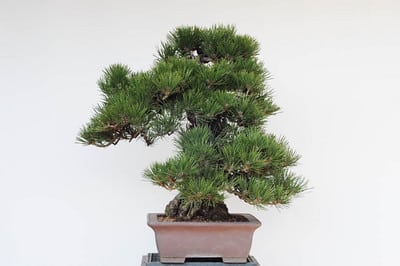
Left – before
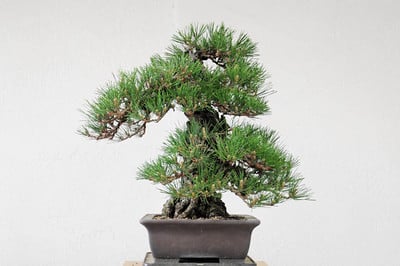
Left – after
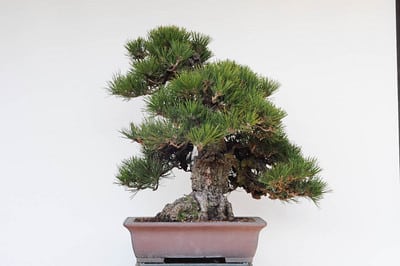
Back – before
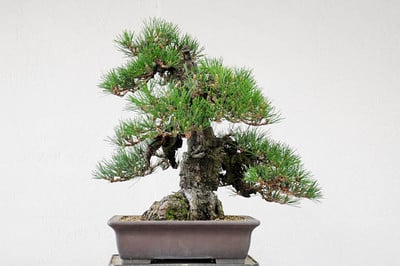
Back – after
The work began with removing the old wire. As the tree had grown quite dense, this turned out to be a chore. I worked with a pliers to help with the branches between which my hands wouldn’t fit.
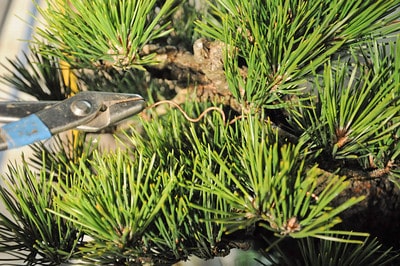
Unwiring copper wire (looks like 14 gauge)
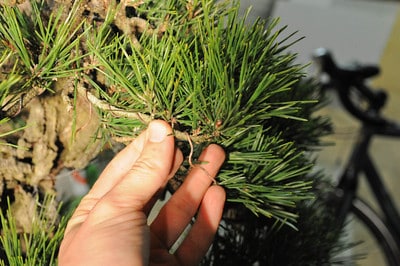
I secure the wire and the branch with my left hand
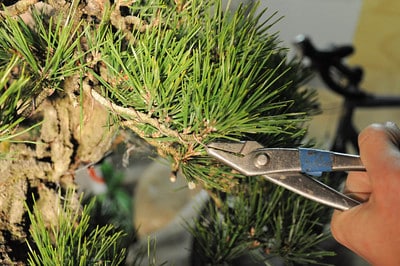
And remove the wire with the pliers, one loop at a time
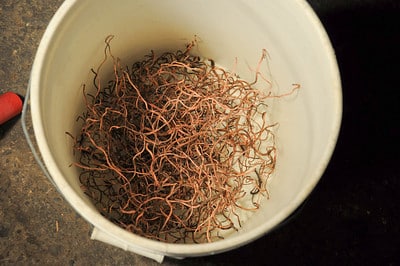
The wire gets recycled
I found a few places where old wire had cut in. Swelling occurs quickly in cork pines, and tight wire accelerates this. As long as the wire doesn’t cut in too deep, the natural corking will disguise the marks within a year or two.
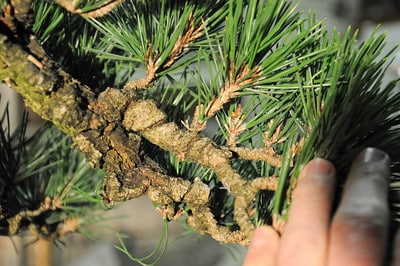
Wire marks
As the pine was in bloom when I began wiring, I removed the pollen cones to avoid making a powdery mess.
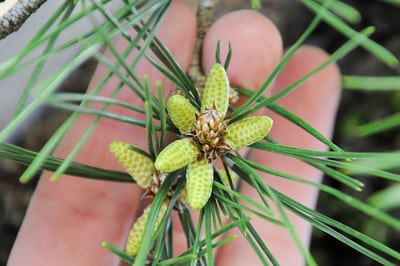
Spring shoot with male, or pollen cones
As you can see from the detail shots below, the branches are very early in their development. Some areas of the tree, like the one pictured below, consist of parallel shoots with buds along the length of each shoot.
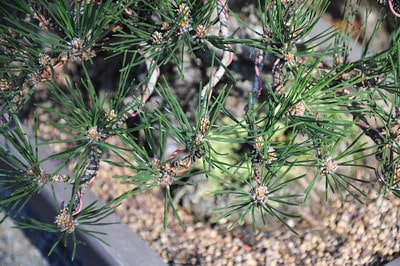
Young branches
Other areas consist of short, stubby shoots. When these areas develop further, I’ll have far more options for creating an attractive silhouette.
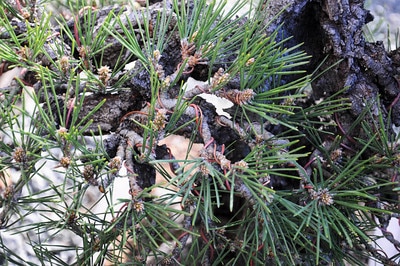
Short shoots
Once more mature branches are in place, I can focus on improving the tree’s balance. And somewhere along the way, I’ll be able to show it again.
Subscribe to Bonsai Tonight
New Posts Delivered Every Tuesday and Friday
Justin Rotert says
Hey sorry to bother you guys again but there are many corkbark (OAKS) around where I live, If I were to airlayer it would the same principles apply to it also once I got through the bark?
xwires says
Justin – although I imagine the same principles apply, I have no experience air-layering cork oaks. Another reader may have a suggestion.
Aarin Packard says
Hi Jonas,
Could you please explain why you uncoil your wire instead of cutting it off?
Thanks
xwires says
Hi Aarin – I tend to cut large gauge wires and de-wire the smaller gauges. De-wiring is typically faster than cutting and it protects against leaving a small section of wire that may cut in if not discovered. It’s also good wiring practice as the same hands are doing similar work. Some teachers in Japan encourage the use of pliers when de-wiring, others prefer a completely manual approach. I do some of each depending on the tree. As it was hard to get to the interior wires on this pine, I found pliers to be the more effective alternative. Cutting small wires on the tree would have been difficult.
Janet Roth says
Aarin, with smaller gauge wire, you risk damaging the bark on the branch or twig if you try to cut it – in addition to its being hard to see, and hence causing you to maybe miss some and leave it there. With bigger wire, unwinding it tends to cause more damage (and with really big wire is impossible) – and bigger wire is easier to see, thus making it harder to leave some behind. The aim is to remove all the wire without harming the tree…
Heo says
I guess the tree would be balance if you cut off the top.
xwires says
Hi Heo – Good suggestion. I’ve been considering removing the top for years as it would provide an easy solution to the balance issue. In the past two years I’ve worked with two Japanese bonsai professionals who both recommended keeping the same front and keeping the apex. I’ve begun to understand the decision more in the past year, however I may not be totally convinced until the rest of the silhouette falls into place. My main reason, to date, for keeping the apex is that it gives the tree character. If I can get beauty to follow, all will be well.
Daniel Dolan says
Hello:
I am a member of the Midwest Bonsai Society in Chicago and Editor of our Newsletter. I have a feature Section titled, “Web Discoveries,” that I would very much like to place a story about Bonsai Tonight.
I have known about it for some time but recently saw it at Michael Hagedorn’s website and spent time reviewing the Archive which is very interesting.
I would like to request permission to use some image [not sure which yet] from your site to illustrate the article.
We have about 250 members and are a not-for-profit organization.
You can see the newly redesigned Newsletter at:
http://www.midwestbonsai.org and Select Feb/Mar/Apr to see a typical issue.
Look forward to hearing from you.
One question about your recent work on your Black Pine…..it appears that you performed your needle plucking during the Spring. Please pardon my novice question but, in the frustrating process to correlate the many care and development techniques for different trees, it was my understanding that the optimal time for needle plucking pines was Late Autumn/Early Winter.
Would appreciate your comments.
Best regards,
D/D
xwires says
Hi Daniel – thanks for the note. Feel free to use images from the site for your newsletter (it’s an impressive newsletter, btw!).
As for the question about when to pluck pine needles – you have it right, late fall, early winter is a great time to pluck needles. Later in winter also works, and select needles can be removed at decandling time. I actually plucked the needles on this corkbark pine in January, but didn’t have time to complete the wiring until April. One of the best reasons to remove old needles earlier rather than later is that interior buds get more light and insects have fewer places to hide. Hope this helps! Jonas